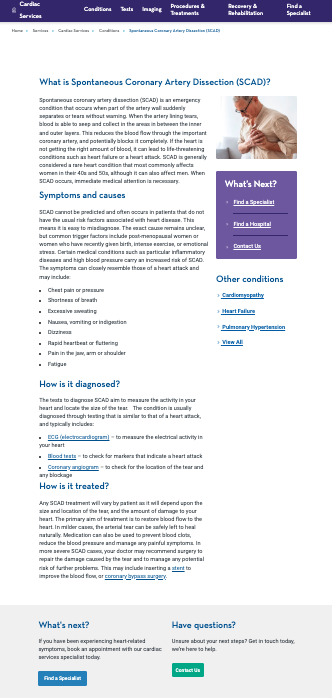![]()
Service
Blog, content development, SEO content
The Brief
Launch the innovative Cardiac Services optimised content hub working closely alongside SVHA and an external SEO agency. This enormous project required extensive content on a range of heart conditions, treatment pathways, cardiac testing, surgical procedures and cardiac rehabilitation.
SVHA: Cardiac Services Hub launch
After the success of the recent Orthopaedic Hub, Cardiac Services was approved for launch. I developed extensive content on a range of heart conditions, treatment pathways, cardiac testing, surgical procedures and cardiac rehabilitation to provide an accessible information point for potential and exisiting patients.
Example copy: Spontaneous Coronoary Artery Dissection (SCAD)
What is Spontaneous Coronary Artery Dissection (SCAD)?
Spontaneous coronary artery dissection (SCAD) is an emergency condition that occurs when part of the artery wall suddenly separates or tears without warning. When the artery lining tears, blood is able to seep and collect in the areas in between the inner and outer layers. This reduces the blood flow through the important coronary artery, and potentially blocks it completely. If the heart is not getting the right amount of blood, it can lead to life-threatening conditions such as heart failure or a heart attack. SCAD is generally considered a rare heart condition that most commonly affects women in their 40s and 50s, although it can also affect men. When SCAD occurs, immediate medical attention is necessary.
Symptoms and causes
SCAD cannot be predicted and often occurs in patients that do not have the usual risk factors associated with heart disease. This means it is easy to misdiagnose. The exact cause remains unclear, but common trigger factors include post-menopausal women or women who have recently given birth, intense exercise, or emotional stress. Certain medical conditions such as particular inflammatory diseases and high blood pressure carry an increased risk of SCAD. The symptoms can closely resemble those of a heart attack and may include:
- Chest pain or pressure
- Shortness of breath
- Excessive sweating
- Nausea, vomiting or indigestion
- Dizziness
- Rapid heartbeat or fluttering
- Pain in the jaw, arm or shoulder
- Fatigue
